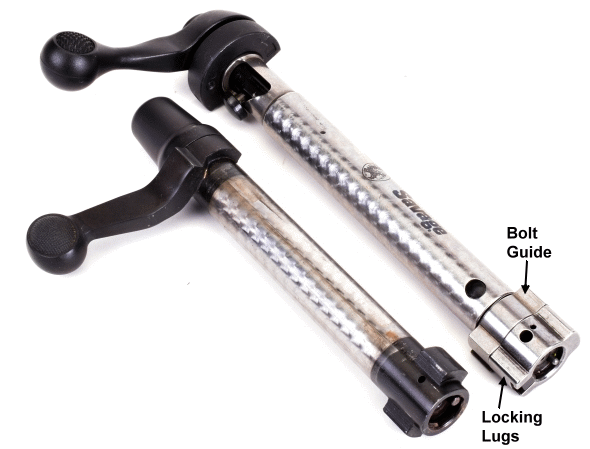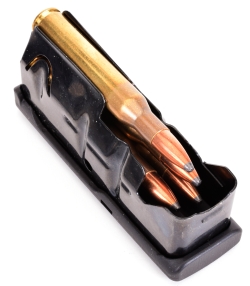
My first firearm purchase was a Savage single barrel Model 220B shotgun. The Savage joined a Marlin Model 336 that had been a Christmas gift of a first centerfire rifle from my parents. The year was 1958 and I was twelve years old.  Pictured, right, the barrel has been cold blued several times, the mismatched stocks have been refinished about the same and most of the case hardened finish is worn off the receiver.
Pictured, right, the barrel has been cold blued several times, the mismatched stocks have been refinished about the same and most of the case hardened finish is worn off the receiver.
I know, “What’s the point of all of this old guy blather?” Well, it just so happens that the new, but very traditional, Model 114 Savage American Classic was packed with a great deal of nostalgia to the extent is caused me to feel a little homesick and to miss old friends. The new Model 114 Savage rifle looks like a quality bolt action rifle of the 1950’s; dark walnut and blued steel, craftsmanship without extraneous frills. The look of a rifle that grows better with age and wears the accumulated marks of experience well.
Savage, already well known for it lever action centerfire and pump and bolt action rimfire rifles, introduced its first bolt action centerfire rifle in 1920, cleverly labeled the Model 1920. The Model 1920 was followed by the one piece barrel/action Model 23 in varmint calibers like the .25-20 WCF and .32-20 WCF in 1923 and the Model 40 in a similar design, but chambered for the larger .250-3000 through to the .30-06 Springfield in 1928.
The forerunner of Savage’s current lineup was designer Nicholas Brewer’s 1958 Model 110. Brewer’s objective was to create a firearm that would be low cost to manufacture, easily adapted to left and right hand operation and in short and long action versions. The original design met that criteria and went on to become very popular. Production of both short and long action rifles began in 1962. The Model 110 action was not only produced by Savage in very large numbers, but it was also incorporated into German Anschutz-Savage sporting rifles and used by many gunsmiths as the basis for fine custom firearms.
In 1966, Savage introduced the Model 110C, an evolution of the Model 110 design. The subject Model 114, like most of the modern Savage centerfire line, is a unique configuration of the Model 110C.
A little hardware detail… in no particular order
The original Model 110 bolt construction was very similar to the current Remington Model 700 bolt, pictured below. The locking lugs were set back and the bolt face extended forward so that the bolt face recessed in the face of the barrel when the bolt was closed.
The Savage Model 110C has what appears to be a leading and trailing set of locking lugs. In actuality the rear “lugs” constitute a bolt guide that rotates freely about the bolt’s body while traveling within tracks cut into the inside walls of the receiver. The guide within these tracks keeps the bolt supported and moving in a straight line. The result is very slick bolt throw with none of the odd pressures and cycling rough spots found in most other bolt action rifles. With the Savage’s bolt closed, a cartridge case head is contained within the rifle’s recessed bolt face.

One of the things we do when blueprinting Remington Model 700 actions in the shop is to lap the contact surfaces of lugs and lug seats to assure full contact. The Savage Model 110C, and therefore the Model 114, have a floating bolt head that trues the lugs to the action’s the lug seats without rework or modification.

Pre 1966 Model 110C receivers had a right side ejection port wall that was on a plane higher than the front receiver ring gas port. It was thought that this feature contributed to the rigidity of the Savage action and reputation for accuracy. The 110C type receiver has a somewhat lower ejection port wall, as pictured. I would suspect that the cause for lowering the port wall on the 1966 redesign was to accommodate low scope mounting and the need for a lower ejection angle.

The three position tang safety is convenient. Moved full aft, the bolt is locked and trigger movement is blocked. Midpoint, the bolt can be cycled, however, trigger movement is blocked. Forward position, red dot is fully exposed, the bolt can be cycled and trigger movement is clear. A pin projects from the center of the bolt shroud when the rifle is cocked.
 The bolt handle leg is tucked in close to the stock, however, the bolt knob is within easy grasp. The benefit of the bolt handle geometry is that despite the opposing two lug 90º lift, the shape of the bolt handle provides clearance for large scope eyepieces.
The bolt handle leg is tucked in close to the stock, however, the bolt knob is within easy grasp. The benefit of the bolt handle geometry is that despite the opposing two lug 90º lift, the shape of the bolt handle provides clearance for large scope eyepieces.
Detachable magazine bolt action rifles are much more common than they were even five or six years ago, however, most are made of polymer products. The Savage magazine body is a formed steel piece that is stagger filled, but center fed. A cartridge case rim always contacts the bolt face at the same location and feed is more reliable when used in concert with a push feed design like the Savage Model 114. The magazine cannot be topped off through the rifle’s ejection port, however, it can be single loaded in that manner.
Sometimes a design that makes for economical manufacture also works to assure accuracy and longevity. The tubular steel receiver is less costly to produce, but it is also easy to bed and easy to keep a bolt, action and bore centerline in alignment. The Savage’s recoil lug is keyed to the receiver to prevent it from rotating, the barrel shank does not have a locating shoulder. Instead, during assembly the barrel is screwed in to contact with a headspace setting gauge and then the barrel nut is tightened to fix the barrel’s position.

The Savage AccuTrigger represents a combination of features. The first feature is a well designed trigger that, in the case of hunting models like the American Classic 114, is pull adjustable between 2 1/2 and 6 lbs, Varmint and target model Savages can be adjusted downward to 1 1/2 lbs. A light trigger pull is indicative of minimal trigger sear engagement which, in other circumstances, means a sensitivity to shock and the chance of the sear being released if a rifle is jolted. The AccuTrigger has a small hinged tab in the center of the trigger, the AccuRelease, that must be compressed to unblock movement of the rifle’s sear.
As sporting firearms further develop, manufacturers are creating systems to simplify stock to barrel mating and to make that fit more precise. Savage is no exception as demonstrated with their AccuStock with embedded aluminum frame. However, in keeping with the American Classic theme the Model 114 is traditionally bedded.

The wood is completely sealed, the inletting cuts are clean and precise and the barrel floats in the forearm. There is little compression load on the stock as the two fasteners pass through the metal frame of the trigger guard and detachable magazine well, through two ferules marked above by arrows and into the receiver. The stock is uniformly clamped between the bottom metal and barreled action, but in a way that prevents crushing the wood.

The bottom pieces are investment cast steel which is a nice touch in comparison to some of the plastic and aluminum pieces that are finding their way onto premium priced rifles. Buttons push and return and latches latch and unlatch precisely. The finish of all parts match the texture and color of the rest of the hardware.
In order to remove the rifle’s bolt, the trigger is pulled and held rearward while a bolt release button is depressed. It takes a little practice to get used to this system, but the effort required is not more than two steps requires by other brand firearms.

The stock is secured to the action at two points… no, not the wood screw behind the trigger guard, but rather one hidden under the bolt release button and the other sort of beneath the magazine release. The bottom metal is recessed around the magazine release to make operation even with a gloved hand an easy task.
Conclusion… for now
As a person who typically spends his days with Remington, Ruger and Winchester rifles, the Savage Model 114 American Classic was found to be interesting and the Savage historical research was enjoyable. The American Classic is a well made hunting rifle that warrants pride of ownership.

Contrary to what I’ve read in places where people go to profess the need to redesign whatever they don’t substantially understand, I don’t find the Savage’s bolt lift particularly heavy and the Model 114’s barrel nut is streamlined enough to… belong. I wouldn’t mind a slightly better recoil pad. Even a 270 Winchester can wear on a shooter after an extended range session. I probably wouldn’t be disappointed if the stamped steel detachable magazine was changed to one of poly construction. I had no problem with the magazine as is, however, experience tells me that the type eventually springs or wears a bit and no longer reliably feeds. Again, I experienced no such problem with this product.
|
Savage Model 114 American Classic |
|
| Manufacturer | Savage Arms – Massachusetts |
| SKU # | 17795 |
| Action Type | Bolt Action |
| Caliber | 270 Winchester |
| Mag Capacity | 4 – Detachable |
| Barrel Length | 22″ |
| Rifling | 1:10″ |
| Weight | 7.5 Lbs |
| Overall Length | 42.75″ |
| Stock | American Walnut – Satin Finish |
| Hardware | Carbon Steel – Matte Blue |
| Length of Pull | 13.75″ |
| Sights | Clean |
| Scope* | Drilled & Tapped |
| Trigger Pull | Adjustable 2.5 to 6 Lbs |
| Safety | 3 Position Tang |
| MSRP | $922 |
| Weaver Bases Included | |
Factory ammo was shot and handloads were worked up for further product assessment, which will be reported in Part 2. I can say that with inexpensive 130 and 150 grain factory ammo, the rifle crowded MOA without difficulty and was well behaved at the shooting bench and in field shooting positions.
Savage’s Model 114 American Classic Part 1
Savage’s Model 114 American Classic Part 2

Email Notification